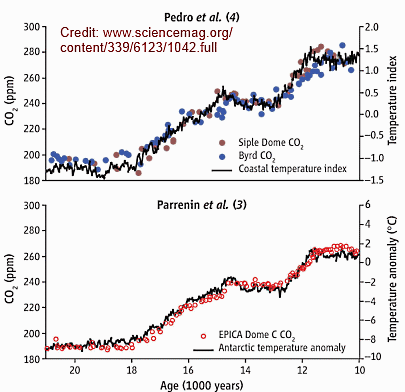|
|
|
|
|
|
|
News & Views item - March 2013 |
![]() Simultaneity of Increased CO2 Concentration and Temperature Increase
Confirmed. (March 1, 2013)
Simultaneity of Increased CO2 Concentration and Temperature Increase
Confirmed. (March 1, 2013)
 The
Australian Science Media Centre (AusSMC)
reports that analysis of Antarctic ice cores in the journal Science
today has found that temperatures and atmospheric carbon dioxide amounts
increased simultaneously during the last major warming period, some 20,000 to
10,000 years ago. The results clarify a long running argument that rises in CO2
after the last Ice Age occurred after rather than before temperature increases
and help dispel the notion that climate warming could not have been caused by
increasing concentrations of atmospheric CO2.
This study uses alternative methods to confirm findings by Australian scientists
released in July last year. Lead author of last year’s Australian study comments
below.
The
Australian Science Media Centre (AusSMC)
reports that analysis of Antarctic ice cores in the journal Science
today has found that temperatures and atmospheric carbon dioxide amounts
increased simultaneously during the last major warming period, some 20,000 to
10,000 years ago. The results clarify a long running argument that rises in CO2
after the last Ice Age occurred after rather than before temperature increases
and help dispel the notion that climate warming could not have been caused by
increasing concentrations of atmospheric CO2.
This study uses alternative methods to confirm findings by Australian scientists
released in July last year. Lead author of last year’s Australian study comments
below.
Dr Joel Pedro Honorary Research Fellow at the Antarctic Climate & Ecosystems CRC, University of Tasmania makes the following observations:
The take home message from this paper is that temperature and CO2
increased in lock step during the warming out of the last glacial period.
We came to the same conclusion using independent methods and different ice cores
last year in a paper published in Climate of the Past
(http://www.clim-past.net/8/1213/2012/cp-8-1213-2012.pdf). In terms of advancing
the science this is good, we now have two studies by different groups of authors
using different methods and several different ice cores coming to the same key
result: that Antarctic temperature and atmospheric CO2 increased essentially in
synchrony as the Earth warmed out of the most recent glacial period.
It is still a big challenge to pinpoint exactly what natural processes were
responsible for such a tight feedback process at this time. Scientists in the
carbon cycle and climate modelling communities working on this problem should be
aided by the improved observations from the ice cores.
To provide a little more detail and background. A technical barrier confronting
studies like Parrenin et al and ours from last year is that there is an inbuilt
time offset in all ice cores between the CO2 and temperature record. The offset
arises because temperature information is encoded at the surface in the
composition of the water molecules in the snow itself, whereas the CO2
is captured at around 60-120m deep as the pores in the snow close off. This size
of the offset, which we call ‘delta-age’, depends on snowfall and temperature
and can range from a few decades to over a thousand years. We must correct for
delta-age in order to provide an accurate assessment of the real past time
relationship between temperature and CO2.
For many cores the reported uncertainties in delta age were previously so large
as to swamp results on the temperature and CO2
relationship. In Pedro et al we worked around this problem by using high
snowfall ice cores from close to the Antarctic coast for which the delta age is
much smaller. Parrenin et al use cores from central Antarctica with larger delta
age, but use a completely new method that appears to greatly reduce
uncertainties for those cores, and correct an earlier bias which consistently
overestimated it.
Finally, it is important to point out that coupled rise in temperature and CO2
that marked the end of the glacial period occurred gradually, over about 8000
years. In contrast what we have seen since the start of the industrial
revolution is a similar CO2 increase
occurring over only a few hundred years. This is way faster than anything in the
ice core record and it’s clearly human-caused. Just as the steady increase in CO2
helped to melt the ice caps and warm the Earth out of the glacial, the rapid
increase now in CO2 is also driving up
temperatures, only at a much faster rate.”